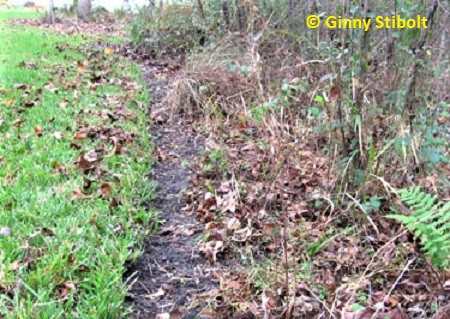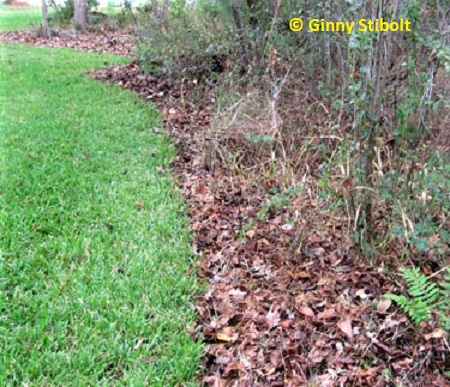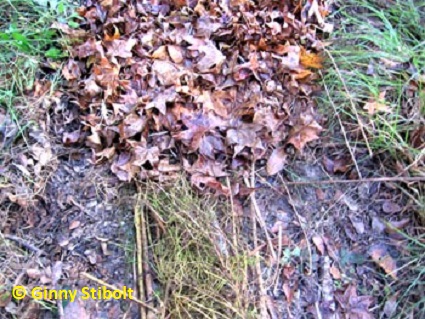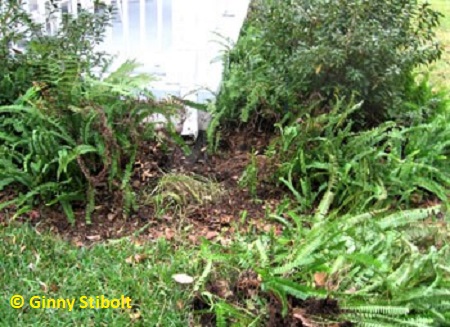Adventures of a Transplanted Gardener |
|||
Cutting edges
|
|||
  The edges of lawn are cut back every second year or so. Fall/winter is a good time to do this because the leaf litter makes a good mulch for the new non-laawn areas. |
Managing the edges
Here's my cutting edge strategy. I remove grass runners from the wooded and mulched areas using a shovel or claw and bend back as many runners as I can toward the lawn. Murphy's Law of lawn care is that grass may not do well in an area, but when you remove it and install a mulched bed instead, the grass will try to repopulate the very same area that it hated before. Cutting the runners will stimulate sprouting, but folding them back and weaving them into the lawn does not. After removing the wayward grass, I tamp down the exposed soil by walking on it and then I rake a thick layer leaves over the soil. I again walk along this area to compress the leaves and to keep most of them from blowing away.
I do this ever second or third year, so the plants in the wooded and mulched areas are usually larger than the previous years and hang over the edge of the grass. I remove another six inches to a foot or more of grass on each trip around the yard. If I keep this up, pretty soon the lawnmower guy (my husband) will have a lot less to do!
We've reduced the care needed for the lawn by replacing difficult-to-mow sharp corners with gentle curves that our riding lawnmower can easily negotiate. Broad, gentle undulations in the borders of the lawn provide interest in the overall landscape, but too many tight turns are more difficult to mow, and may make the garden area look too chaotic. While we haven't installed the plastic edging along most of my lawn edges, doing so would probably reduce the maintenance even more if the edge were to remain static and not creep further into the lawn.
One of the objectives of a more sustainable lawn is to reduce the use of string trimmers and leaf blowers. One of my friends asked why I just didn't use a leaf blower instead of hand raking. My answer was that I was reducing the lawn, getting more exercise, pulling weeds, removing all the leaves and other stuff from the turf grass (that the leaf blower would leave behind), plus it's sooo much quieter than the 90-decibel racket produced by leaf-blowers. And then there's the little thing about the high amount of air pollution. Some two-stroke engine leaf blowers can emit as much as 25 percent raw unburned gasoline in their exhaust. The Los Angeles chapter of the American Lung Association has produced research to illustrate how leaf blowers generate as much pollution in one hour as a car driven for 100 miles. In many Californian cities, there are exchange programs for leaf blowers with engines that don't pollute so much, but there will still be all the noise.
 |
Re-mulching paths
As part of our annual meadow management, I clear the vegetation from the pathways. I dig out the runners and remove the brambles near the path so it's comfortable to walk or run a wheelbarrow there. As I chop down or pull up tall plants such as pine trees, dogfennel (Eupatorium capillifolium), goldenrod (Solidago spp), and grasses, I lay their stalks along the paths. Then I apply a generous layer of dead leaves on top of the long stalks and stomp the leaves to break them into smaller pieces. Later I'll gather pine needles from the gutters and streets in our neighborhood. Pine needles on top of the leaf layer will make an attractive pathway mulch and will last the whole year until next fall when Mother Nature will again provide the perfect weather for working and an abundance of mulching materials.
Thinning the ferns from the downspout rain garden
 |
When I planted this rain garden a couple of years ago, I dug a small drywell under the area and planted some blue eyed grass, rain lilies, and two types of ferns--ebony spleenwort (Asplenium platyneuron) (sic) and netted chain ferns (Woodwardia aerolata). There are more details on this project in my article on rain gardens.
Well, the spleenworts have really been successful and I have plans to enlarge this rain garden later in the spring, so I pulled most of the spleenworts from the rain garden. Now I'll be able to see what else is still growing there this spring. I plan to remove a significant amount of lawn from this area. It hasn't done all that well and it would be a perfect place for a woodland path from the front porch over to the pond. More on this project in the next few months.
I recommend more ferns, less turf grass, and clean edges for ease of care as part of your greener landscape!
(Update: I found out later that the ferns that I thought were slpeenworts were actually the invasive tuberous swordfern (Nephrolepis cordifolia). No wonder it did so well! I have since then pulled it all out and have worked to eliminate it from the wooded area between our house and the neighbor's where they have a huge stand. I have not been able to convince the three sets of neighbors in that house over the years to do anything about it, but maybe one day...)
Ginny Stibolt is a life-long gardener, a botanist, a naturalist, and a garden writer. You may contact her or read more of her articles posted on her website: www.greengardeningmatters.com.
Copyright Ginny Stibolt

